Now & New
55th Annual Fukuyama Rose Festival: Blossoming from A Thorny Past
We all know that saying, “all roses have thorns,” which reminds us that no matter how good something or someone looks, there’s always a darker side that doesn’t surface or simply gets ignored in favor of the light side. To say that Japan’s modern history has been checkered would be an understatement, especially for Hiroshima Prefecture, but those who look back on a certain place’s track record need only decide whether the proverbial glass is half-empty or half-full. The COVID-19 pandemic which has been plaguing the world for the past two years has left a blemish on the annals of Fukuyama City with events being cancelled or diminished left and right, but the fruitful outcome of their latest festival has demonstrated that the City of Roses has blossomed again to the point where the petals now outnumber the thorns.
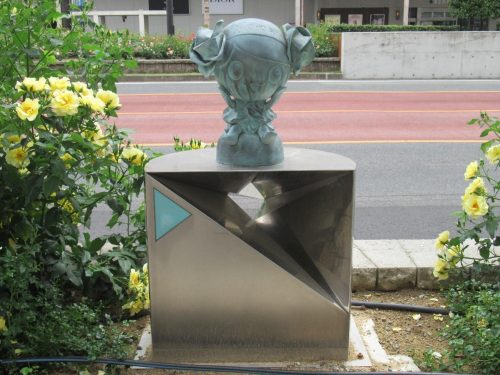
Fukuyama indeed lives up to its moniker with rose bushes lining the way from Fukuyama Station southward to the department stores across the street, in addition to having no fewer than three parks scattered throughout the city center, all adorned with roses spanning a spectrum of vivid hues. The mascot of Fukuyama City is a rosy sprite named Rola, as depicted by the statue above. She is well-loved by her citizenry and even has her own position (jersey number 2025) on the Fukuyama City Football Club! As can be surmised due to being a sprite, she enjoys eating sweets, with rose-flavored soft serve ice cream being her favorite, and her dream is to spread the mentality of “Rose Mind”—which entails consideration, kindness, and mutual aid—all over the world. Without a doubt, the most renowned and anticipated representation of said Rose Mind would be the Fukuyama Rose Festival held every May, with this year’s being held on the weekend of the 14th and 15th and marking the 55th celebration since the festival’s inception.
Festival Stroll
The catchphrase for the Rose Festival is 「楽しくなけりゃ祭じゃない!」, which means, “if it ain’t fun, it’s not a festival!” Fukuyama seemed to take this saying seriously as I didn’t see any COVID-related limitations (other than the encouraging of wearing masks in public) on the events like I did back in Kure and Hiroshima City over Golden Week. Like it always has been, the festival sites this year were always scattered throughout the city center with heavy concentrations in the rose-filled parks, so no one section of Fukuyama ever got overwhelmingly crowded. There was no shortage of food vendors on the streets selling yummy delights just for the festival, and the city’s beloved street performers could be spotted on just about every block, naturally accompanied by a crowd of onlookers.
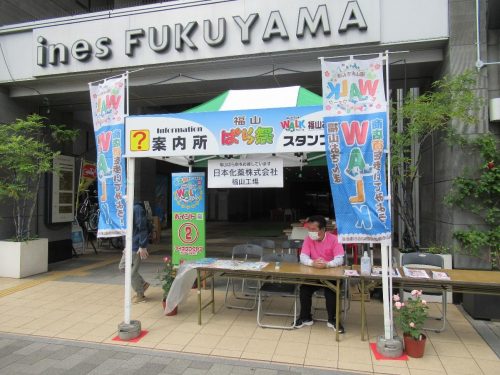
The most conducive aspect to the Rose Festival’s spread-out structure would most likely be the stamp rally. There was a total of nine tents such as the one you see above, each staffed with peppy volunteers ready to hand you a festival booklet to help you start your journey or stamp a particular spot in your booklet, putting you one step closer to completion. Having a stamp rally ensures that festivalgoers check out every nook and cranny of the festivities, as well as promotes increased walking all over the city, which is not only healthy, but reduces the number of cars and prevents congestion that would occur if people were to drive between the festival sites. Accruing stamps from all the sites qualifies people to enter a drawing and win one of a variety of prizes; all participants will at least get a snack for their efforts, so no one leaves the festival empty-handed. While it may be tempting to buy food here and there and donate to a street performer or two, it is possible to enjoy the Rose Festival without spending any money at all as the sights themselves—from the stunning roses to the lively atmosphere of locals wowing at the performances and culinary delights—warrant a day trip to Fukuyama, or even an overnight stay if you wish to partake in the festivities on both days.
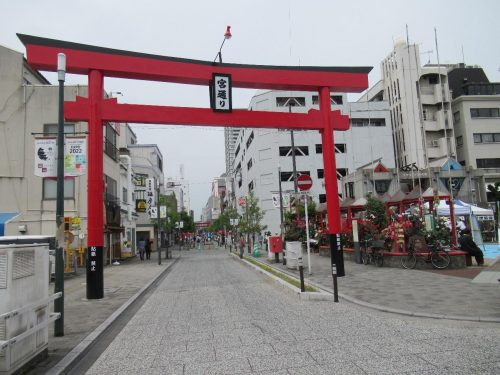
I dropped by Fukuyama on Sunday, the 15th, and started exploring right as the festivities had begun. Obviously, the first thing I did was get my booklet so I could get the stamp rally sights done and dusted, and along the way I came across many points of interest. Besides the three parks with roses abound, the most noteworthy festival site was Miyadori, a street with a red torii at either end, and between each gate was a plethora of stands with food, drinks, and small festival games to get the kiddos excited.

Whole families attended the Rose Festival in droves, and some girls had even gotten into the festival mood by donning traditional kimonos, albeit with sneakers for comfort. As it was still morning, I wasn’t yet hungry, but looking at all the foods for sale seriously tempting me into buying a snack for the sake of it. However, I managed to resist that temptation for the time being, and instead examined each stall to contemplate what to buy in the afternoon, when my friend would be available to join me in the festivities. Until then, I meandered here and there, catching sight on amazing spectacles such as local choir groups and acrobats juggling lit torches, but just off of a shopping arcade in a tiny park was a woman showing off her mad skills with a diabolo (also known as a Chinese yo-yo). For one trick, she attached a dragon-like streamer to it before launching it vertically into the air for extra visual appeal.
Around Fukuyama Station
Noon came around, which meant it was time for me to meet my friend right outside Fukuyama Station. Thankfully, I didn’t wander too far while hitting up the bulk of the sites on my stamp rally, so I was able to show up first. Since I still had to wait around a bit, I decided to walk through the station building to the plaza by the north exit, right by Fukuyama Castle, which was still closed for renovations. To nobody’s surprise, there was a street performer here too, but what I found more impressive were the food trucks offering up a variety of cuisines, such as mango juice, Kasaoka Ramen (the city of Kasaoka being Fukuyama’s easterly neighbor in Okayama Prefecture), and even Mexican tacos! Once again, I had to exercise some self-restraint as I wanted my friend and I to stuff our faces with festival food together.
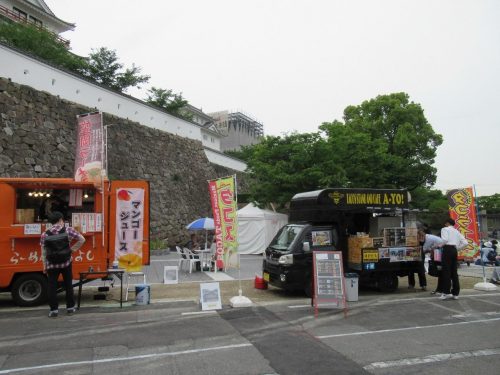
As I was worried my friend might have already arrived and been frantically scanning the crowds for me south of the station, I decided to head back to the south exit to find an appropriate waiting spot. What better meetup point than a street performer’s stage where everyone was gravitating? It may sound counterproductive, but at least my friend couldn’t guess that I’d be anywhere else. This man was a middle-aged acrobat who toyed with the laws of physics to create optical illusions, seemingly suspend spinning objects in midair, and perform daring stunts that nobody in his or her right mind would ever do. I must say that I was quite moved (pun totally intended) by this performer’s brave tricks, and for a short while I completely forgot to search for my friend.

From my messages, I found out that my friend and I were watching the same show, but we waited until the performance was over to actually seek out each other. After reuniting, we agreed to make tracks for the three parks further south, where all the roses were and the fun would truly begin. Neither of us was particularly hungry at the time, so we skipped past the food stands of Miyadori and continued on our merry way.
Three Parks, Endless Roses
Our first stop was Chuo Park (which means “Central Park,”), and we were taken aback by what we saw before even entering through the front gate. Visitor after visitor was lining up to have a picture taken with a living statue (provided a donation is made beforehand), and even those who didn’t take photos at least stopped to stare. I too got my picture with the silent, hardworking performer before checking out the sites at Chuo Park.

Chuo Park had everything a typical festival site would have—food stalls, a stage for dancers, and needless to say, roses. Besides another stamp rally table, there wasn’t much else worth sticking around for, so we left quickly and made haste for the second park on our agenda: Bara Park (which means “Rose Park”). It doesn’t take a genius to figure out why it carries that moniker, as Bara Park sports the most roses in all of Fukuyama, featuring cultivars from around the world. These roses had some of the most creative and thought-provoking names: one scarlet variety was called “Olympic Fire,” and as much as the fiery hue reminded me of an Olympic torch, the reminder of the Olympic Games I was unable to attend last summer was a touch disheartening. There was also a rose named “Anne Frank,” a girl who hid in a secret room with her family for over two years, and frankly put, made our COVID lockdowns look like a joke.
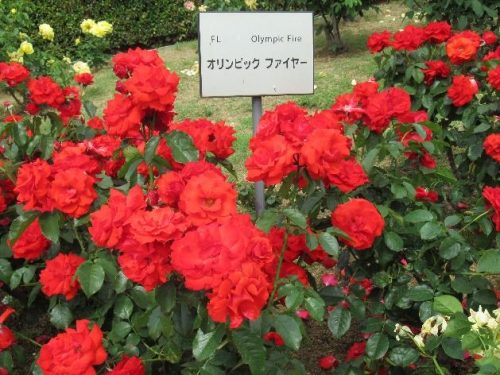
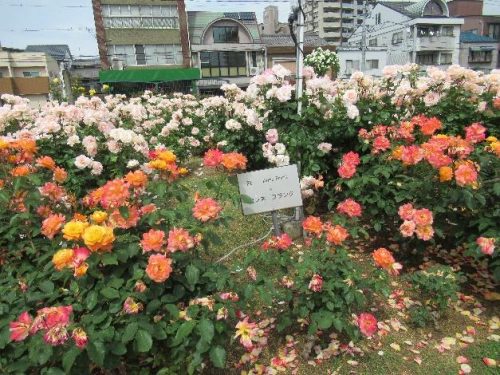
However, my spirits would be lifted after ascending the temporary makeshift platform in the middle of the park, affording guests a phenomenal view of roses in every direction. The sheer variety in color made the entire park look like one giant painting. As if the branching paths and tunnel of roses weren’t enough, the additional festival stalls this weekend ensured that one could well spend the entire afternoon admiring this park alone.
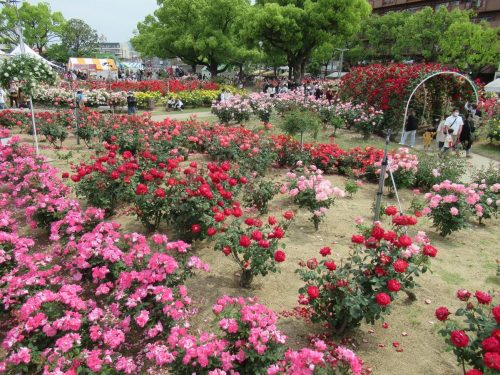
Alas, there was one more festival site to hit up, so we hit the road and eventually came upon Midoricho Park (which means “Green Town Park”), the largest park we would visit today. This naturally meant that Midoricho Park would have the most event space, food stalls, and enough roses to rival Bara Park! Appropriately enough, the roses at this event site bear names of food and beverages, a perfect fit for this weekend’s festival. It was around this time in the later afternoon that my tummy finally started to grumble, so I listened to it and started scouting out some eats.

The stalls at Midoricho Park sold all the fare you’d expect—grilled meat skewers, kara-age chicken, ice cream, fresh lemonade, et cetera—but to my relief, also had some local ethnic joints selling festival-sized portions of their usual restaurant items. I went for a choice that gave me to best bang for my buck: Indian curry on rice, more of a full-fledged meal than some mere snack being offered at other stalls. All this food for a paltry \500 (one coin!) meant not only that I’d be full, but also that I’d save money since I wouldn’t need to hit up any more food stalls for the rest of the day. On top of that, this curry was the real deal when it came to spice, the numbing piquancy demanded constant sips of water, and was a fresh departure from that mild, Japanese gravy-like roux.
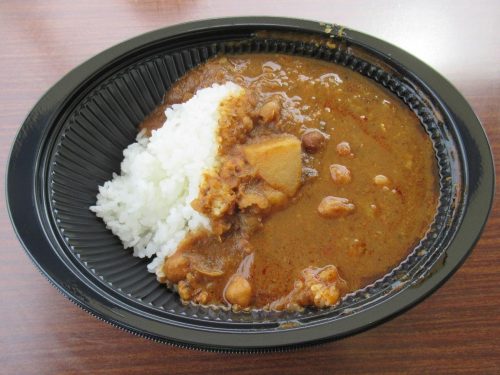
Near the end of my meal, the MC on stage announced that yosakoi performers would be dancing to “Fukuyama Ondo,” a song that riled me up when I heard it during the Hiroshima Flower Festival. I told my friend that I insisted on seeing this one live, so as soon as I finished my curry, we dashed to the stage area. The sheer number of people in conjunction with COVID restrictions meant that there were specific lines where people entered the stage area, but even those were confusing because the line snaked to the point where it more resembled a blob of people. As a result, my friend and I got separated, but I prioritized getting myself a seat first lest I miss out on the action.
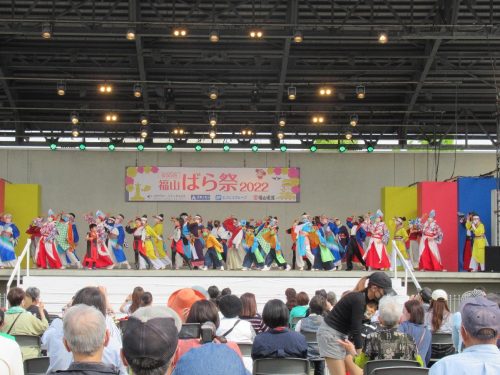
Moment of Joy: Harvesting Memories
This Fukuyama Ondo dance was the exact same as what was on the Dahlia Stage in Hiroshima ten days prior, but this time, the stage was wider and there were yosakoi dancers from a variety of troupes participating. Moreover, since this piece seems to be a classic among Fukuyama residents, the spectators in front of me knew exactly what to do during the song, waving their arms to mimic the on-stage performers’ movements. The enchanting atmosphere that arose with the loud, catchy music and enthused audience definitely reaped memories of past festivals that were sown as recently as Golden Week, and had I not been busy photographing and videotaping this scene, I might have joined the locals, who were engrossed in only the Fukuyama Ondo itself, in their stationary dance. I only hoped my lost friend was able to witness even a smidgen of this dazzling spectacle, as it’s hard for me to imagine any other performance that day more fit to end my day at the Rose Festival.
Fukuyama Rose Above
After the Fukuyama Ondo concluded, I left the stage area and finally found my friend again. We decided to get away from the noise and crowds by retreating to the raised, hexagonal plaza with a gazebo and benches at the top of the stairs. It was our first period of relaxation after racing between one festival site and the next, so we spent a considerable amount of time up here just sitting, talking, and enjoying the view. Near the end of the festival, I mentioned that I had yet to visit all the stamp rally sites, so we got up and huffed it to the remaining locations so I could at least claim a consolation prize for my participation. From that point, it was back to Fukuyama Station, where we said our goodbyes and I boarded my train back to Hiroshima City.
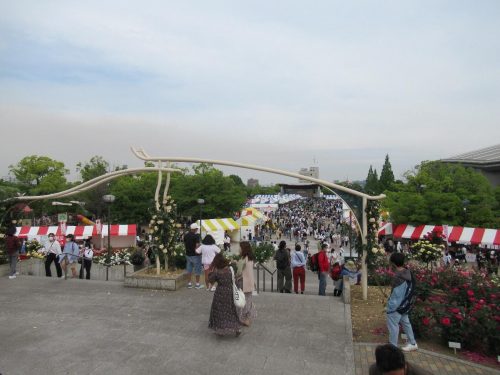
Indeed, petals had fallen off the Rose City of Fukuyama in the years 2020 and 2021, but 2022 has shown promising rejuvenation by what I saw today, and the Rose Festival is but one example. I hadn’t been to a festival as normal as this since Shobara’s Sakura Festival last month, but something tells me that over the course of the next few months, festivals will slowly but surely ease their restrictions and become the former fun events that they once were. We may have to use this year’s summer and autumn festivals as indicators, but as roses bloom both in May and October, I have an abundance of confidence that Fukuyama—and Hiroshima Prefecture as a whole—will experience revivals in their seasonal events. In due time, those metaphorical thorns will be reminders of our past struggles rather than our current reality, and those who visit Japan will once again be free to attend any festival they choose to build the perfect bouquet of a vacation here.
Written by the Joy in Hiroshima Team
